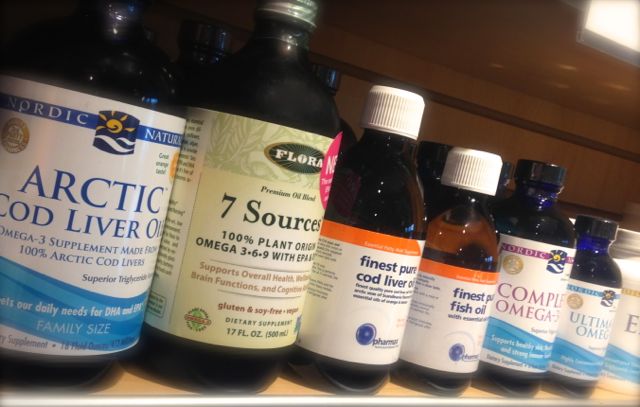
I am frequently asked what I think the best “fish oil vitamins” or omega-3 fatty acids are. It’s a great question, because I believe everyone should be taking omega-3’s, but it depends on why you want to take them. Here’s a quick synopsis of the need for fats, and some details of the most important fats: omega-3 fatty acids.
The Rudiments of Fats
There are 3 types of Nutrients: Proteins, carbohydrates, and fats.
Fats are needed in our diet because they provide energy, are the building blocks of hormones, make up the lining that surrounds every cell in the body (phospholipid bilayer), and they insulate nerve fibers. 60% of the brain is made up of fat.
There are two main types of dietary fats: Saturated and unsaturated. Saturated fats are bad because they are converted into bad cholesterol (LDLs), which is linked to heart disease and strokes. Saturated fats mostly come from red meat, dairy products, coconut oil, and cocoa butter (chocolate… so sorry).
Unsaturated Fats
There are 5 Categories of unsaturated fats (of which trans fat is the only unhealthy type):
- Monounsaturated fats (avocado, canola, nuts, olives) reduce the risk of heart disease.
- Polyunsaturated (from corn, safflower, sesame), also reduce the risk of heart disease.
- Cis fats are found in animals (unrefined fish oil) and plants (unrefined flax oil).
- Trans fats were developed by the food industry (margarine, vegetable shortening, deep fried foods). They increase the risk of heart disease by raising your bad cholesterol (LDL) and lowering your good cholesterol (HDL).1
- Omega fatty acids (3, 6, 9)
Omega Fatty Acids
The working surface of our brains is made up of fatty acids. Omega-3 and Omega-6 fatty acids are considered essential because they are needed for health, but the body can not make them. Some experts believe that a proper balance between omega-3 and omega-6 needs to be maintained and that the typical American diet contains way too much omega-6. Other experts disagree. Linoleic acid is the main omega-6 fatty acid in food. Omega-6 fatty acids provide both necessary inflammatory and anti-inflammatory mediators in the body. Food sources rich in omega-6 include seeds, nuts, soybeans, lunch meats, and corn oil.
Omega-3 Fatty Acids
 There are eleven different types of omega-3 fatty acids, but nutritionists primarily focus on three: Alpha-linolenic Acid (ALA), Eicosapentaenoic Acid (EPA), and Docosahexaenoic Acid (DHA). The primary dietary sources of ALA include flax seed oil, canola oil, soybean oil, and walnuts. The main source of dietary EPA and DHA come from fish and they get it from algae.
There are eleven different types of omega-3 fatty acids, but nutritionists primarily focus on three: Alpha-linolenic Acid (ALA), Eicosapentaenoic Acid (EPA), and Docosahexaenoic Acid (DHA). The primary dietary sources of ALA include flax seed oil, canola oil, soybean oil, and walnuts. The main source of dietary EPA and DHA come from fish and they get it from algae.
Omega-3 Fatty acids serve many roles in the body, all of which are not fully known. Locally acting messenger molecules, called prostaglandins, are made from Omega-3’s. Infants who get insufficient amounts of omega-3 fatty acids from their mothers during pregnancy may develop vision and nerve problems. Other symptoms of low omega-3 fatty acid deficiency include heart problems, poor circulation, mood swings, depression, and poor memory.
Benefits of Omega-3 Fatty Acids
Heart Disease: Omega-3 has been shown in multiple studies to aid in both primary and secondary prevention of cardiovascular disease. 2, 3, 4
Lowers cholesterol: Omega-3 oils can help decrease the amount of LDLs your body produces by reducing the rate apoprotein B synthesis.5
High blood pressure: It decreases both systolic and diastolic blood pressure even in patients that have cardiovascular disease.6
Improved brain function: The brain is full of omega-3 fatty acids, so it is not surprising that studies have shown that omega-3 can improve cognitive performance.7 A deficiency of omega-3 fats has resulted in poor memory, mood swings and depression.
Rheumatoid and Osteoarthritis: Omega-3 has been shown to decrease pain and inflammation in both rheumatoid and osteoarthritis.8, 9
Macular Degeneration: Since there is a high concentration of omega-3 fats in the eyes, it turns out that it can decrease the risk of macular degeneration.10
The strongest evidence for health benefits from Omega 3 fatty acids is in decreasing the body’s risk for heart disease. Many researchers disagree on the percentage of omega-3’s that should come from of ALA, EPA, and DHA, but most recognize that EPA and DHA are more beneficial for the heart.
ALA
According to the American Heart Association, ALA may also decrease the risk of heart attack and ischemic heart disease. A study conducted in 2005 concluded that a modest dietary consumption (2-3 g/day) of alpha linolenic acid was recommended for the prevention of coronary heart disease.11 However, a good dose for the average person is around 100 to 200 mg a day.
Some vegetarians attempt to take large amounts of flaxseed oil knowing that the human body has the ability to convert ALA into EPA and DHA. The problem with this strategy is that the body can only convert a small amount (usually less than 5% in men). Women can convert more ALA, but to get a reasonably recommended amount of EPA/DHA by conversion from ALA is close to being unreasonable. However, the advantage of flax seed oil is that it does not contain mercury, dioxin or PCBs, yet these toxins could potentially be found in trace amounts in fish oil capsules.
EPA
An added benefit of omega-3’s has been demonstrated with EPA. A 5-year study monitored over 18,000 people with high cholesterol and concluded that supplementing the diet with EPA achieved secondary prevention of strokes.12 200 to 300 mg a day is a good daily dose of EPA.
DHA
Most DHA is taken up by the brain, nervous system and eyes, so taking it to keep your brain and your eyes healthy makes sense. But a new study found that higher intake of DHA helped slow the rate of telomere shortening.13 Telomeres are found on the end of chromosomes and essentially, the shorter the telomeres become, the less life there is left in the body. So, DHA may turn out to extend life. The typical dose is between 200 and 300 mg a day.
Dosing Recommendations
By now you should be convinced that you need omega-3, but how much you should take depends on your age and what conditions you are treating. The American Heart Association recommends 1000 mg of EPA/DHA a day for people with heart disease and 2000 to 4000 mg a day for people with high triglycerides under the supervision of a doctor. Pregnant women may want to try and take 200 to 300 mg of DHA each day.
One caution that I would add is that taking more than 3000 mg of Omega-3 (which would be about 10,000 mg of fish oil) can cause excessive bleeding, and to be careful with that high of a dose.
Best Quality and Purest Omega 3 Fish Oil
Ocean fish are great sources of omega-3, but also can be contaminated with pollutants like mercury and PCBs. Many high quality fish oils are purified to remove contaminants and toxins, which you may not be able to find in an Equate-like brand. The best omega-3 for kids, if you choose to give it to them, should most definitely have contaminants removed, because their bodies will have a harder time coping with the minute amount of toxins than an adult’s body. If it is purified, it will usually state that on the package. You also want to make sure that the major source of omega-3 comes from fish and not soy or other vegetables. Look at the EPA and DHA content and make sure it is sufficient. If it is not listed on the bottle, that is probably a red flag. For more information, check out: My Recommendations for the Best Brands of Omega-3 Supplements.
References
- “Trans fat: Avoid this cholesterol double whammy”. Mayo Foundation for Medical Education and Research (MFMER). http://www.mayoclinic.com/health/trans-fat/CL00032.
- Marchioli R, Barzi F, Bomba E, et al. (2002). “Early protection against sudden death by n-3 polyunsaturated fatty acids after myocardial infarction: time-course analysis of the results of the Gruppo Italiano per lo Studio della Sopravvivenza nell’Infarto Miocardico (GISSI)-Prevenzione”. Circulation 105(16):1897-1903.
- Kris-Etherton P, Harris W, Appel L. (2002). “AHA Scientific Statement: Fish consumption, fish oil, omega-3 fatty acids and cardiovascular disease. Circulation 106: 2747–2757.
- Lavie C, Milani R, Mehra M, Ventura H. (2009). “Omega-3 Polyunsaturated Fatty Acids and Cardiovascular Diseases”. J Am Coll Cardiol, 54:585-594.
- Illingworth D, Harris W, Connor W. (1984). “Inhibition of low density lipoprotein synthesis by dietary omega-3 fatty acids in humans”.Arteriosclerosis, Thrombosis, and Vascular Biology 4:270-275.
- Vandongen R, Mori TA, et al. “Effects on blood pressure of omega 3 fats in subjects at increased risk of cardiovascular disease”. Hypertension22: 371-379.
- Kalmijn S, Van Boxtel M, Ocké M, et al. (2004). “Dietary intake of fatty acids and fish in relation to cognitive performance at middle age”.Neurology 62:275–280.
- Berbert A, Kondo C, Almendra C, et al. (2005). “Supplementation of fish oil and olive oil in patients with rheumatoid arthritis”. Nutrition21:131-6.
- Kremer JM. (2000). “N-3 fatty acid supplements in rheumatoid arthritis”. Am J Clin Nutr. (suppl 1):349S-351S.
- San Giovanni J, Chew E, et al. (2008). “The relationship of dietary omega-3 long-chain polyunsaturated fatty acid intake with incident age-related macular degeneration. Arch Opthalmol. 126(9): 1274-9.
- Mozaffarian D. “Does α-linolenic acid intake reduce the risk of coronary heart disease? A review of the evidence”. Alternative therapies in health and medicine 11(3): 24–30.
- Tanaka K, Ishikawa Y, Yokoyama M, et al. (2008). “Reduction in the recurrence of stroke by eicosapentaenoic acid for hypercholesterolemic patients: subanalysis of the JELIS trial”. Stroke 39(7): 2052-8.
- Farzaneh-Far R, et al. (2010). “Association of Marine Omega-3 Fatty Acid Levels With Telomeric Aging in Patients With Coronary Heart Disease”. JAMA 303(3): 250-257.
photo credit: convivial.org
